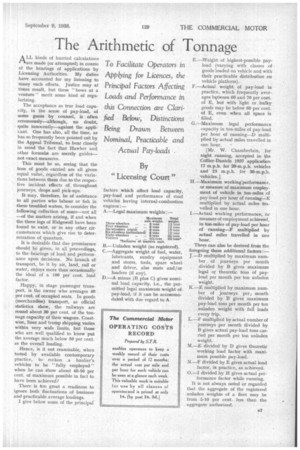The Arithmetic of Tonnage
Page 41

If you've noticed an error in this article please click here to report it so we can fix it.
To Facilitate Operators in Applying for Licences, the Principal Factors Affecting Loads and Performance in this Connection are Clarified Below, Distinctions Being Drawn Between Nominal, Practicable and Actual Pay-loads .
By "Licensing Court"
ALL kinds of hurried calculations are made (or attempted) in course al the hearings of applications by Licensing Authorities. My duties have accounted for my listening to many such efforts. Justice may at times result, but these "bows at a venture " merit some kind of regularizing.
The acceptance as true load capacity, in the sense of pay-load, of some guess by counsel, is often erroneously--although, no doubt, quite innocently—against the applicant. One has also, all the time, as has so frequently been pointed out by the Appeal Tribunal, to bear closely in mind the fact that Hawker and other formulx are merely guides— not exact measures.
This must be so, seeing that the tons of goods carried are all given equal value, regardless of the variations between them due to the respective incident effects of throughout Journeys, drops and pick-ups.
It may, therefore, be of assistance to all parties who labour or fish in these troubled waters, to consider the following collection of some—not all —of the matters arising, if and when the three legs of Ridgewell have been found to exist, or in any other circumstances which give rise to determination of quantum.
It is desirable that due prominence should be given, in all proceedings, to the bearings of load and performance upon decisions. No branch of transport, be it by air, land, rail or water, enjoys more than occasionally the ideal of a 100 per cent. load factor.
Happy, in stage passenger transport, is the owner who averages 40 per cent, of occupied seats. In goods (merchandise) transport, as official statistics show, the railways are round about 30 per cent, of the tonnage capacity of their wagons. Coastwise, liner and tramp shipping varies within very wide limits, but those who are well qualified to know put the average much below 50 per cent. as the overall loading.
Hence, is it not reasonable, when tested by available contemporary practice, to reckon a haulier's vehicles to be "fully employed" when he can show about 90-50 per cent, of maximum possible in fact to have been achieved?
There is too great a readiness to ignore both fluctuations of business and practicable average loadings.
I give below some of the principal factors which affect load capacity, pay-load and performance of road vehicles having internal-combustion engines
A.—Legal maximum weights : —
Maximum Total axle weight. weight. Three-wheelers ... 8 tons 12 tons Four-wheelers 8 tons 12 tons Six-wheelers trigidi 8 tons 19 tons Six-wheelers (araculated) 8 tons 19 tons Eight-wheelers ... 8 tons 22 tons Trailers _ 64 tow 22 tons' "inehisire ol tasettre unit.
B.—Unladen weight (as registered).
C.—Aggregate weight of fuel, water, lubricants, sundry equipment and stores, tools, spare wheel and driver, also mate and/or loaders (if any).
D.—A minus (B plus C) gives nominal load capacity, i.e., the permitted legal maximum weight of pay-load, if it can be accommodated with due regard to A. E.—Weight of highest-possible payload (varying with classes of goods loaded on vehicle and with their practicable distribution on vehicle platform).
F.—Actual weight of pay-load in practice, which frequently averages bOweert 60 and 70 per cent. of E, but with light or bulky goods may be below 60 per cent. of E, even when all -space is filled.
G.—Maximum legal performance capacity in ton-miles of pay-load per hour of running—D multiplied by actual miles travelled in one hour. • [Mr. W. Chamberlain, for night running, accepted in the Collier-Daniels 1937 application 17 m.p.h. for 20-m.p.h. vehicles and 23 m.p.h. for 30-m.p.h. vehicles.]
H.—Maximum working-performance, or measure of maximum employment of vehicle in ton-miles of pay-load per hour of running—E multiplied by actual miles travelled in one hour.
I.—Actual working performance, or measure of employment achieved, in ton-miles of pay-load per hour of running—F multiplied by actual miles travelled in one hour.
There can also be derived from the foregoing these additional factors:— J.—D multiplied by maximum number of journeys per month divided by B gives maximum legal or theoretic tons of payload per month per ton unladen weight.
K.—E multiplied by maximum number of journeys per; month divided by B gives maximum pay-load tons per month per ton unladen weight with full loads every trip.
L.—F multiplied by actual number of journeys per month divided by B gives actual pay-load tons carried per month per ton unladen weight.
M.—E divided by D gives theoretic working load factor with maximum possible pay-load.
N.—F divided by E gives actual load factor, in practice, as achieved. 0.—I divided by II gives actual per formance factor while running.
It is not always noted or regarded that the aggregate of the registered • unladen weights of a fleet may be from 5-10 per cent. less than the aggregate authorized.




















































































